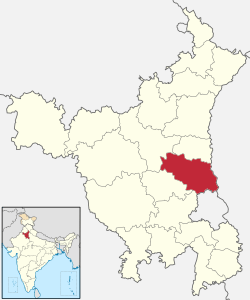Gohana
| Gohana गोहाना City of Sweets Introduced =2006 | |
|---|---|
| City | |
 Gohana  Gohana Location in Haryana, India | |
| Coordinates: 29°08′N 76°54′E / 29.13°N 76.9°ECoordinates: 29°08′N 76°54′E / 29.13°N 76.9°E | |
| Country |
|
| State | Haryana |
| District | Sonipat |
| Government | |
| • Type | Chairman |
| • Body | Nagar Parishad Gohana |
| Elevation | 225 m (738 ft) |
| Population (2011) | |
| • Total | 121,637 |
| Languages | |
| • Official | Hindi ,Regional Haryanvi |
| Time zone | IST (UTC+5:30) |
| PIN | 131301 |
| Telephone code | 91-01263 |
| Vehicle registration | HR 11 |
Gohana (Hindi: गोहाना) is a city and a municipal council in the Sonipat district of the Indian state of Haryana (pincode 131301).
Geography
Gohana is located at 29°08′N 76°42′E / 29.13°N 76.7°E.[1] Its topography consists mainly of low plains, but its south-central area has a small plateau. Gohana's 43 km2 (27.95sq mile) land area has an average elevation of 225 metres (738 feet), peaking at Mount Afadjato at 880M (2,887 feet).[2]
Demographics
Gohana city is situated in the Sonipat district of Haryana. It is a main subdivision with a population of more than 300,000 (as of 2011). It has its own municipality and a constituency for Haryana Vidhan Sabha. There is around 86 Villages in Gohana. It is located in the west of the Sonipat District, 40 km from the town of Sonipat. Earlier, it was part of Rohtak district. Gohana is the oldest tehsil of Haryana. It was declared a tehsil in 1826 by the British, and some structures which show evidence of that time are still standing in the city: the City police station, Government Boys' Senior Secondary School, Government Girls' Senior Secondary School, and the Haryana Public School are some examples. Gohana City has its own Courts and Mini Secretariat, situated on Sonipat Road, in the eastern part of the city. "Nagar Palika Gohana" is the governing body of the city.
In ancient times, Gohana was known as Gavambhavana and was considered a sacred place. Prithviraj Chauhan constructed a fort here, which was later destroyed by Muhammad Ghori after defeating Prithviraj in 1192. Later, in 1947, all Muslim families left this place and migrated to Pakistan. Being a tehsil city, people from diverse communities reside in the city.
As of 2011 India census,[3] Gohana had a population of 121,637. Males constitute 53% of the population and females 47%. Gohana has an average literacy rate of 78%, higher than the national average of 74.5%: male literacy is 89%, and female literacy is 65%. The city is also famous for its jumbo sized jalebi
Notable Citizens
- Mool Chand Jain
- Bhagat Phool Singh - In his name, the first women's university in North India - "Bhagat Phool Singh Mahila Vishwavidyalaya" (also known as BPS Women's University) - was established at Khanpur Kalan, a village near Gohana. He first transformed this holy land into a centre of learning for girls when he started a Gurukul for girls in 1936. After some time, a Gurukul was opened for boys in the village Bhainswal Kalan (in the vicinity of Gohana) in 1919 which today is the South Campus of the University.
The Gurukul started with only three students but grew in size, stature and reputation with time and in November 2006, the Haryana Legislative Assembly passed a Legislative Notification, vide no. 31/2006, making the Gurukul a full-fledged State University.
Education
There are multi-disciplinary colleges in Gohana, the most prominent being the Govt. PG College, BPS Mahila University and Bhagwan Parshuram College of Engineering. There are also many private B.Ed and D.Ed Colleges in the city. BPS Mahila University has become famous for being the first of its kind, a women-only university in Northern India.
List of Educational Institutions -
- Bhagat Phool Singh Mahila Vishwavidyalaya
- Govt. P.G. College,Gohana
- Satyanand Public School,Gohana
Traveling and distance from major cities nearby
Gohana is well connected with major districts and other small towns/villages. There is a national highway NH 71-A that connects Gohana to Rohtak and Panipat - two major districts, and National highway NH 352A that connects it to district Sonipat and Jind. Trains connect Gohana with Rohtak, Bhiwani and Panipat. New railway line from Jind to Sonipat through Gohana is fully functional since 26 June 2016.[4] City has a railway station which was founded in early 70s and is a Junction now.
Distance from major cities
| City | Distance | Direction |
|---|---|---|
| Chandigarh | 202 km | north |
| Panipat | 42 km | northeast |
| Rohtak | 33 km | southwest |
| New Delhi | 90 km | southeast |
| Sonipat | 40 km | east |
Religion
Hindus constitutes the majority of the religious population. Aside from several Hindu temples in the city, remains exist of old mosques (founded before the country's independence) within the city, many near the market area. A minority population of other religious followers such as Jains, Sikhs, and Christians are notable in Gohana. The Jain population is large enough however, that they have established four temples within the city. Of significant note, the main Jain temple at Holi Mohalla was established over 1,500 years ago and houses a white statue of Lord Parshvnath.
Places of Interest
- Ram Sharnam Ashram, Gohana[5]
- Sanjivni Kaya Shodhan Sansthan,Gohana
- Devi Lal Cricket Stadium,Gohana
- Jawahar lal Nehru Park,Park Road, Gohana
- Rohta Park, Gohana
References
- ↑ Falling Rain Genomics, Inc - Gohana
- ↑ http://geography.about.com/od/ghanamaps/a/ghanageography.htm
- ↑ "DISTRICT CENSUS HANDBOOK" (PDF).
- ↑ "Sonepat and Jind train flagged off". PTI. Sonepat. Press Trust of India. June 26, 2016. Retrieved August 2, 2016.
- ↑ "Ram Sharnam Ashram". Gaurav. Retrieved December 11, 2015.
